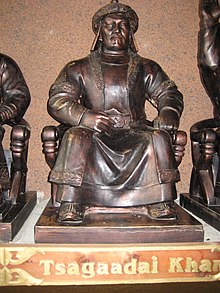

| |
|---|---|
| Khan | |

Statue of Chagatai Khan in Mongolia
| |
| Khan of the Chagatai Khanate | |
| Reign | 18 August 1227 – 1 July 1242 |
| Successor | Qara Hülëgü |
| Viziers |
|
| |
| Born | 22 December 1183 Khamag Mongol |
| Died | 1 July 1242 (aged 58) Almaligh, Chagatai Khanate |
| Consort |
|
| Issue |
|
| House | Borjigin |
| Father | Genghis Khan |
| Mother | Börte |
| Religion | Tengrism |
Chagatai Khan (Mongolian script: ᠴᠠᠭᠠᠲᠠᠶ; Čaɣatay; Mongolian: Цагадай, romanized: Tsagadai; Chagatay: چغتای, Čaġatāy; Uyghur: چاغاتاي خان, Chaghatay-Xan; Chinese: 察合台, Chágětái; Persian: جغتای, Joghatây; 22 December 1183 – 1 July 1242) was the second son of Genghis Khan and Börte. He was appointed by Genghis Khan to oversee the execution of the Yassa, the written code of law created by Genghis Khan in the Mongol Empire.[1] He inherited most of the Central Asian Mongol territory after the death of his father.[2]
Very little is known about Chagatai's earlier life. He was the second son of Genghis Khan and Börte. Chagatai was considered hot-headed and somewhat temperamental by his relatives, because of his attitude of non-acceptance of Jochi as a full-brother. He was the most vocal about this issue among his relations.[3] He was assigned 4 mingghans (led by QaracharofBarlas, Kököchü of Baarin, Müge of Jalairs and Idiqudai Noyan) and an appanage around Altai Mountains in 1206 by his father.[4]
He joined the invasion of Jin Empire in 1211 with Jochi and Ögedei, capturing several cities and invading Shaanxi and Henan in 1213, also plundering Yanggu.[5] Later Chagatai appeared at campaign against Khwarazmian Empire with his father and brothers, capturing Otrar in 1218, Samarkand in 1220, Urgench in March-April 1221. The Urgench campaign was noticeably harder because Chagatai and Jochi failed to co-operate.[4] After this incident Ögedei was appointed commander of the besieging forces and Chagatai was given task of maintaining communication between Mongol forces with building bridges and restoring roads. He returned to his father's side during his siege of Talaqan.[6][4] Chagatai was greatly affected when his son Mutukan was killed during the siege of Bamiyan in 1221.[7]
He was present at the battle where Jalal ad-Din Mingburnu was defeated near the Indus River. He later commanded the rear guard during conquest of Western Xia.
Chagatai succeeded Genghis Khan in his domains in what came to be known as the Chagatai Khanate in 1227 with its capital in Almaliq city, in the valley of the Upper Ili, near the site of the present Kulja, and consequently in the extreme east of his dominion. According to Edward Ross, "his reason for fixing it in that remote position, instead of at BukharaorSamarkand, was probably one of necessity. His Mongol tribesmen and followers—the mainstay of his power—were passionately fond of the life of the steppes."[8] As the eldest surviving son and head of the house, he was present at the enthronement ceremony of Ögedei on 13 September 1229 and supported his reign. Ögedei in his turn sent Güyük as Chagatai's ward. Although Rashidaddin claimed that Chagatai died shortly before Ögedei, Juvayni told of further activities of Chagatai, such as strong support to regency of Töregene. However, he soon died.[9]
His known viziers include Vajir, Baha al-Din Marghinani and Habash Amid. Vajir was described as Turkish, Uyghur[4] and Khitan[10] by different authors. He was employed by Qushuq Noyan from Jalayir tribe to court of Chagatai. Having written a book about history of Mongol Empire, he was regarded highly by Chagatai. He even let him to execute one of his daughters-in-law in charges of adultery. After Chagatai's death, Vajir was executed for treason alongside Chagatai's physician Majd al-Din, since his widow Yesülün charged them with poisoning of Chagatai.[11] Habash Amid was a Muslim Khwarazmian[12] from Otrar and a secretary originally.[13] He was assigned to Chagatai in 1218 and survived the purge thanks to his support for Qara Hülegü.[14] Baha al-Din Marghinani also survived Chagatai, being a friend of his son Yesü Möngke although he was purged later.



Chagatai had two principal wives along other wives and concubines:
According to Rashidaddin, he was a just and competent ruler. Minhaj-i-Siraj Juzjani also considered him to be dignified and open hearted.[21] Muslims viewed Chagatai Khan with negativity and hostility because Chagatai Khan strictly enforced Mongol Yasa law against Islamic Shariah law banning Halal animal slaughter and Islamic prayer ritual ablution as well as the Islamic legal system.[21][22] The Chagatai language takes its name from him, as well as people surnamed Chughtai, city of Joghatai in Iran and Ciğatay village in Azerbaijan.
| Hoelun | Yesugei Baghatur | ||||||||||||||||||||||||||||||||||||||||||||||||||||||
| Börte | Temüjin (Genghis Khan) | Hasar | Hachiun | Temüge | Belgutei | Behter | |||||||||||||||||||||||||||||||||||||||||||||||||
| Jochi | Chagatai | Ögedei | Tolui | ||||||||||||||||||||||||||||||||||||||||||||||||||||
![]() This article incorporates text from The Tarikh-i-rashidi: A History of the Moghuls of Central Asia, by Edward Denison Ross, a publication from 1895, now in the public domain in the United States.
This article incorporates text from The Tarikh-i-rashidi: A History of the Moghuls of Central Asia, by Edward Denison Ross, a publication from 1895, now in the public domain in the United States.
| Preceded by Chagatai khanate established |
Khan of Chagatai Khanate 1225–1242 |
Succeeded by |
|
| |||||||||||
|---|---|---|---|---|---|---|---|---|---|---|---|
| |||||||||||
| |||||||||||
| |||||||||||
| |||||||||||
| International |
|
|---|---|
| National |
|
| Other |
|